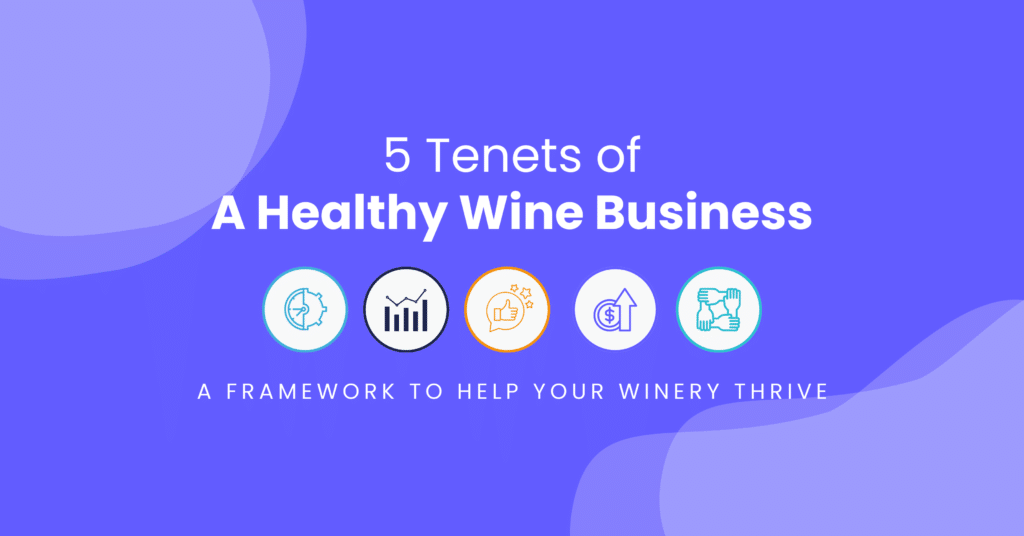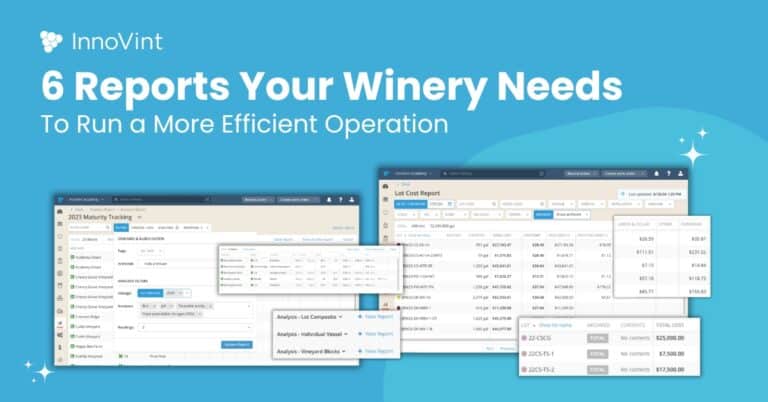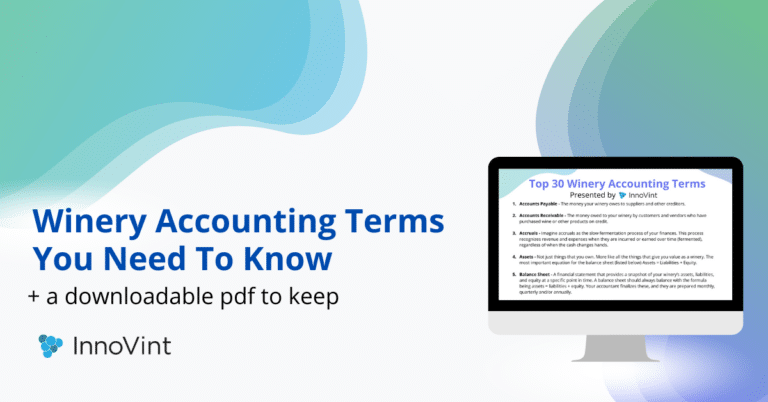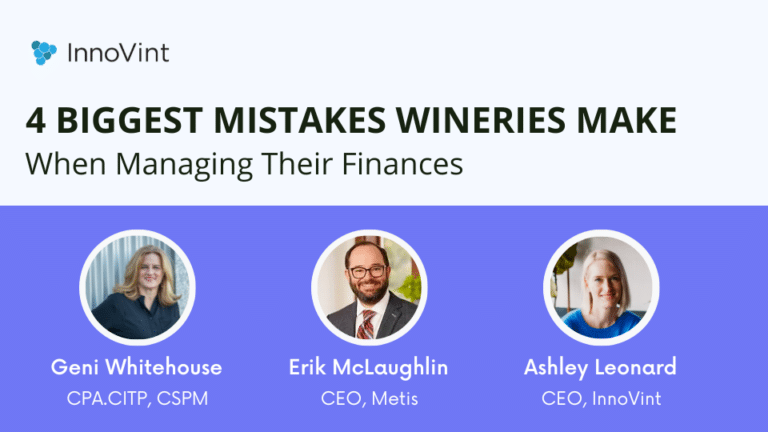“It’s harder than ever before,” a winery owner confided to me recently. It’s not just her. I’m hearing it from producers across the country—running a healthy wine business (which has never been easy) has become even more challenging in the face of new headwinds: declining consumption, reduced tasting room traffic, rising costs, and evolving consumer preferences.
Having spent over two decades in the wine industry, both in winery operations and as the founder and CEO of InnoVint, I’ve had the unique opportunity to work closely with thousands of winemakers and business owners. I’ve seen wineries thrive, and I’ve seen them struggle and go out of business. From these experiences, I’ve developed a comprehensive understanding of what constitutes a successful wine business.
In this post, I’m sharing the Healthy Wine Business Framework, which includes the five core tenets that I believe define a healthy wine business. Want the cheat sheet? Download the Healthy Wine Business Infographic.
The Role of Leadership: It Starts at the Top
Before I jump into the framework, it’s important to mention the role of leadership. In my experience, the biggest difference between whether a winery sustains or struggles is the mindset and focus of its leaders. It starts at the top.
Many winery owners and their management have a reputation for being disinterested in modernization and accepting antiquated ways of working. This needs to change. They need to embrace a more flexible, adaptable mindset. They must remain curious and experimental in order for their winery to remain competitive and thrive over time. This approach to their business yields benefits to both top-line sales and back-of-house efficiencies.
Owner or not, consider your personal mindset for how you approach business decisions. Are you open to more effective ways of operating, or do you prefer to do things the way you always have?
Five Core Tenets of a Healthy Winery
Like many, I have strong opinions on what wineries need to do to thrive in this challenging environment. But instead of just saying it, I wanted to develop a resource that would offer practical, actionable guidance for winery professionals–especially those in leadership roles. I aimed to create a framework that would help you evaluate your company’s current health and implement impactful improvements.
So, what are these five core tenets of a healthy winery? What do all successful wineries have in common?
A healthy, successful winery:
- Is Profitable
- Pursues Operational Excellence
- Relies on Data
- Builds a Positive Work Culture
- Is Community-Centric
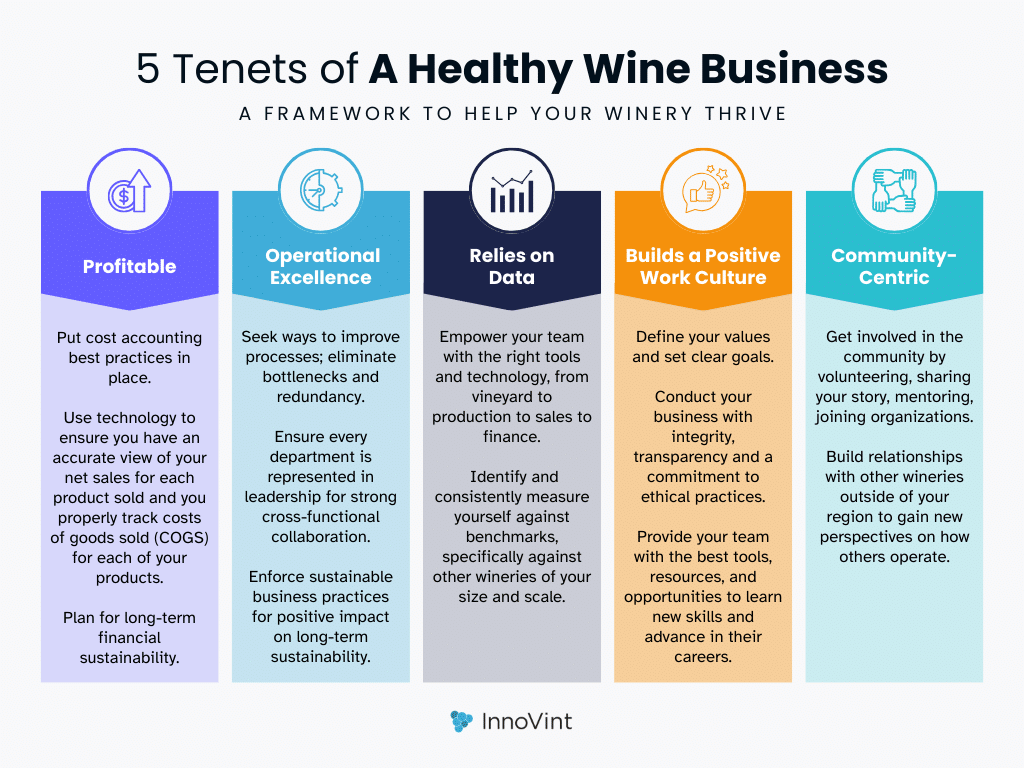
By following this framework and aligning your wine business with these 5 tenets, you set yourself up for the greatest likelihood of success as a business in the wine industry. Now, let’s explore each of them further.
1. A Healthy Wine Business is Profitable
This takes the #1 spot for a reason. Maximizing profitability is the most important aspect of any business. Having a plan to make money and make it sustainably for years to come may seem obvious. But that’s not always the case for wineries. I’ve seen some lose sight of this priority or take their eyes off the wheel of the business, and their cash disappears.
The healthiest wineries have an accurate picture of their business’s financial health, which they use to make important decisions. Whether actually profitable or not, the focus on being cash flow positive and hitting key profitability KPIs drives their winery’s forecast and business model.
One misconception about financial health is that increasing sales revenue automatically assumes cash flow health. This perception often leads to putting too much stock in selling more wine and too little stock in managing costs. Before you know it, costs are out of control, and margins get thinner and thinner. Heck, you may even be losing money on your top seller if the costs to produce it are blowing up on you.
There are three things that a healthy winery that focuses on profitability does well:
- Understands their current net sales for each product sold. You know how much you’re making in sales revenue from each of your products. With the different sales channels (3-tier and direct-to-consumer) your actual sales price can vary wildly once you consider discounts, deals, and promotions.
- Properly tracks costs of goods sold (COGS) for each product produced. You understand all the costs that go into making your wines. This practice means implementing proper winery cost accounting to follow the flow of volume from grape to bottle, leaving you with the true cost of each wine produced. Not all wines cost the same. The smartest wineries implement winemaking software to do this for them, as the dollars seamlessly follow the volume changes across lots. Otherwise, it’s a complete headache to manage cost allocations with your accountant in Excel month over month.
- Calculates true margin for each wine, and forecasts future sales for projected cash flow. A healthy business manages cash flow and plans for long-term financial sustainability. With accurate net sales combined with strong cost accounting practices for each wine, making decisions about which product lines to double down on and which ones to retire is much clearer.
🤔 Why is profitability and financial transparency so challenging for wineries?
Simply understanding how much it costs to make your products and the revenue you generate from each one is quite challenging in the wine industry. It’s a complex manufacturing process like no other! If you’re struggling with tracking COGS accurately, you’re not alone. Tracking unit costs ($ per gallon) from grape to bottle through all the winemaking activity is incredibly difficult. Managing these cost distributions is almost impossible with just Excel. With purpose-built winemaking software (like InnoVint), it becomes much easier. The costs seamlessly follow the liquid through the daily movements. This is the only way to have the perfect building block to then dial in your profit margins.
🔍 Evaluate your winery’s financial health by asking yourself these questions:
- Do you have a financial model, budget, and strategy with clear goals?
- Do you track financial performance, and know industry benchmarks for a winery at your size and scale?
- Do you understand your profitability per product?
- Are you sure you have enough cash to get through any unexpected turbulence?
Dial this area of your business in first! It’s an essential part of running a healthy winery.
2. A Healthy Wine Business Pursues Operational Excellence
Winemaking is a beautifully complex process with critical elements of both artistry and science. The craft will always benefit from the integrated involvement of people–their palates, their attention, and their physical care at each step along the way. That is why it’s absolutely mandatory to run your winery as efficiently as possible. Your people have to be optimized. Without this, too much time is wasted, costs skyrocket, and the business is poorly run.
Successful wineries that have achieved operational excellence:
- Continually seek ways to improve processes, products, and services. Settling for the status quo isn’t an option. You need to experiment and iterate, adopt new technology, tools, and SOPs, while also ensuring operational knowledge is shared and understood among all.
- Eliminate operational bottlenecks and redundancy. You need to ensure you are as lean, efficient, and cost-effective as possible with the resources at hand. This often means retiring archaic methods of working and embracing more modern solutions.
- Have strong cross-functional collaboration. Everything moves slower when departments operate in a silo, leading to weak reporting, bad decisions, and low morale. At a minimum, you need to ensure you have representation from every department on your leadership team (including winemaking!) and build a culture that encourages building relationships across teams.
- Remain compliant. Wineries produce alcohol, which means we are heavily regulated by many government agencies. Any misstep in operations can introduce major compliance risks. For every wine you produce, you need to maintain an audit-ready traceability system for seven years, which requires supreme data management practices.
- Employ sustainable business practices. Being ethically responsible means something different for every winery, but honoring the land and conserving resources is a defining part of our industry. As farmers and manufacturers, you need to ensure future generations have access to the same resources we do. Monitor and take action on areas of your business that can have positive impacts on long-term sustainability.
🤔 Why is operational excellence so challenging for wineries?
As previously mentioned, wineries don’t have the reputation of being super innovative. This industry has been underserved by technology for this reason and is generally behind the times. Ironically, the process of making wine is complex, heavily regulated, and quite deserving of better solutions. It requires purpose-built technology. Modern software is easier to find and adopt these days, but some resistance to change still remains. But for those that innovate with technology, it’s a long smooth ride to efficiency gains, transparency, greater accuracy, fewer mistakes, reduced risk, and overall better operations.
🔍 Evaluate your winery’s operational efficiency by asking yourself these questions:
- Are you more likely to embrace change or resist it?
- Do you have systems in place that simplify operational complexity, not add to it?
- How confident are you that you couldn’t save money on the operations side based on tightening up workflows and processes?
- Do you have any dysfunctional team dynamics? Can you do a better job at unifying them to decrease burden, bottlenecks, and cost?
- Can you easily recall the production details of any wine released to the market over the last seven years?
As leaders, you need to prioritize operational maturity to keep your business in good health.
3. A Healthy Wine Business Relies on Data
In today’s challenging market, being innovative isn’t an option anymore. It’s a necessity. And being innovative requires having – and using! – data to make decisions. You build a successful business by being smart and strategic, not by going with your gut.
The stakes are high when you’re competing with equally good, equally priced, equally resonating brands. This means you must:
1. Empower your team through the adoption of the right tools and technology. How do you measure the most important parts of your business? You need tools to feed you this information. From vineyard metrics to production optics to sales velocity to consumer analysis, it’s a great time to lean into technology, especially if you’re someone who’s been resistant in the past. Software just keeps becoming more accessible, easier to learn, and simpler to use. You don’t need them all, but you do need the strongest in every category, from accounting software to wine production software to DTC software. Here’s a simple chart with some options depending on your needs:
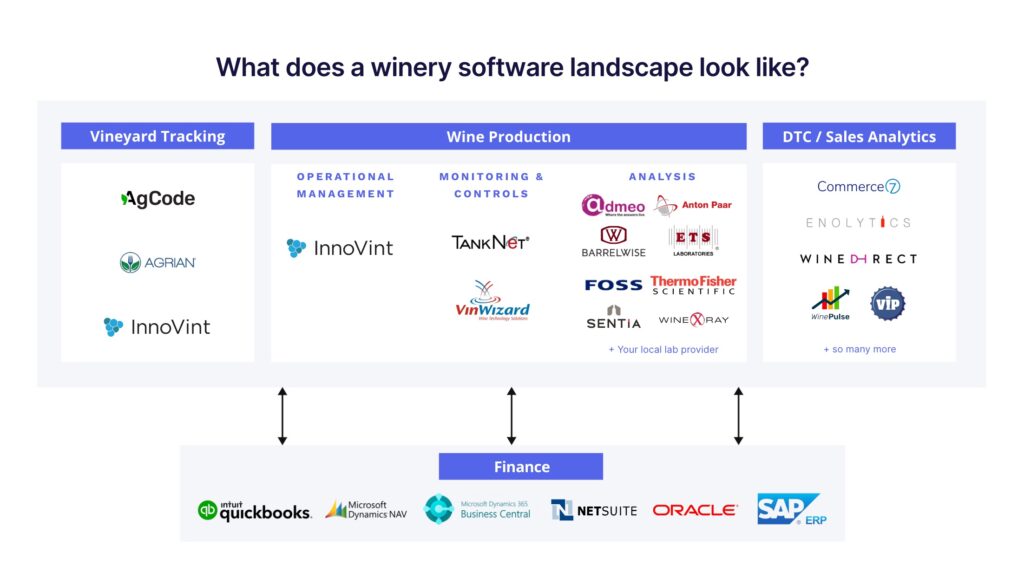
2. Identify and measure yourself against benchmarks. Do you know how you compare to other wineries? You should reference benchmark data to get an initial understanding of where your business falls against industry standards. A lot of folks ask me about financial benchmarks, so let me share a starting point:
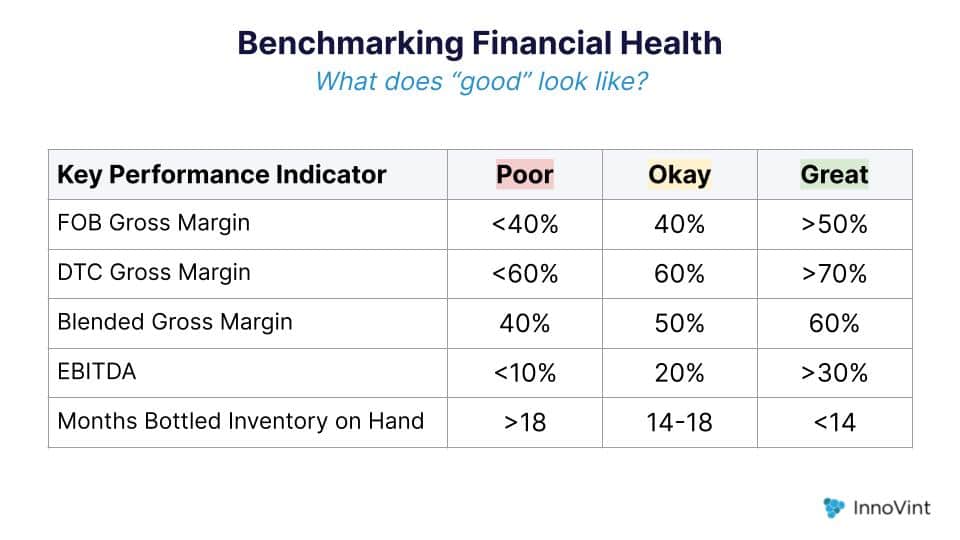
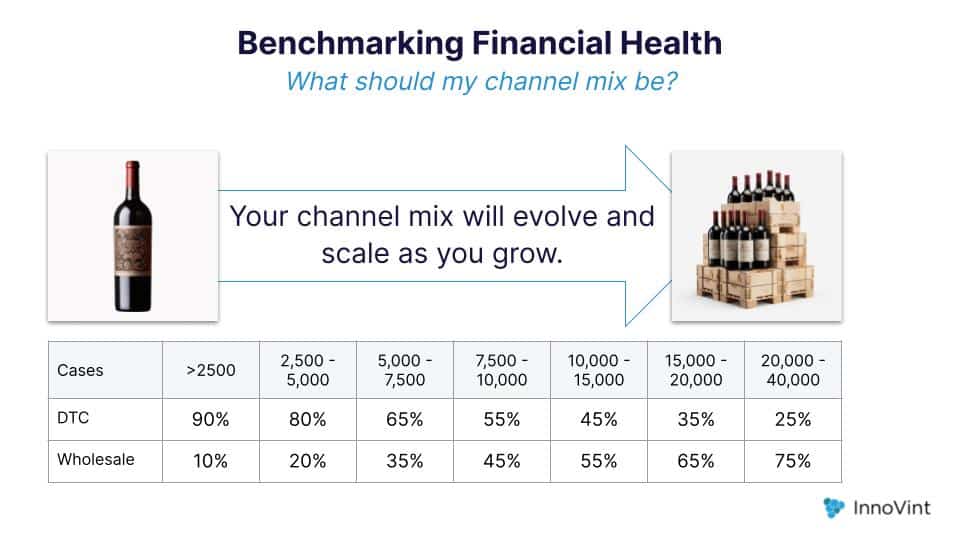
3. Understand your consumers and their preferences. Modern-day wine consumers are not as loyal as they once were. You need to be informed and proactive in your efforts to source new customers and keep them coming back. Data-driven insights platforms, such as Enolytics and WinePulse, exist to help wineries better market. A winery’s sales and marketing efforts should be defended by strong data and informed insights that dictate the strategy.
🤔 Why is relying and acting on data so hard for wineries?
Wineries haven’t been accustomed to prioritizing data insights. Why is that? Two reasons. First, the wine industry is rooted in tradition. Much of it is driven by gut feel and experienced palates. It’s difficult to break the habit of operating on instinct. Second, timely and accurate data has not been easy to come by, especially benchmarks for wine producers to understand how they are doing against their peers.
It takes effort to apply a data-driven mindset to all aspects of your business. With new, modern technology (like InnoVint), wineries can access real-time data to inform decisions. As more emphasis is placed on data, more industry reports and studies will be done to help serve the greater community.
🔍 Evaluate how data-driven your winery is by asking yourself these questions:
- What data are you collecting, and how do you share it across the team to drive decision-making?
- How much faith do you have that you’re using the best technology tools in each segment of your business?
- Are your decisions about which products to make for which channel founded or unfounded?
- Do you understand where your most viable customer cohort is by location and how to best access them?
- What are the key data points that tell you whether your business is successful or not?
Once all wineries adopt this as status quo our industry will be competing with all other industries (including beer and spirits!) at a much higher level.
4. A Healthy Wine Business Builds a Positive Work Culture
Do you want to run a team of uninvested, apathetic people prone to leave you at any time? I didn’t think so. This industry is built on passion! When we feel a part of something greater, and on a team where we’re deeply valued and taken care of, businesses thrive. This all begins with strong leadership, defined values, and clear goals.
Some core elements of a strong work culture:
- Transparency: Share your company goals with your team and integrate them deeply into your vision. Even if you’re the winemaker, you have the power to unite your people around a common mission and inspire them to do their best work.
- Social responsibility: Simply doing what’s right, is an important aspect of the wine industry. We are stewards of the land, tactful with resources, water, and the environment. Many wineries and vineyards fulfill sustainable initiatives and achieve sustainability certifications. They conduct their business with integrity, transparency, and a commitment to ethical practices. This is so important it’s becoming law! This intentional investment can inspire others to follow your lead and commit to your brand.
- Being innovative: Another form of high-impact investment that helps to attract and retain top talent is a commitment to the best tools, resources, and technology to allow them to perform and soar. I’ve seen wine companies fail in their recruiting efforts because they’re not running a modern operation. Experienced professionals don’t want to take a step back into the dark ages in their careers. They want to advance, learn new skills, and continue to refine their practice at your company.
- Reward employees: I’ve worked for wineries with poor culture. They didn’t care much about their people, there was no clear vision for the brand or the business, and there wasn’t a tremendous amount of social or ethical responsibility. I wasn’t inspired. You need to create an environment where people want to be, where they know they can flourish and stand behind your brand. Then, when you have great people, reward them. Reward them with strong rewards packages and market-rate pay. Give them plenty of time off and allow them to work from where they are most productive.
🤔 Why has having a positive work culture been hard for wineries?
A misconception I’ve seen and experienced myself is that winery employees are disposable. Since so many people want to work in wine, everyone is easy to replace, right? Wrong. You should work hard to retain your best people, and you should feel the pain when they leave. Turnover can be an issue, and I think wineries underestimate the negative business impact of this. It slows progress, requires the pivot back to recruiting, hiring, and ramping them, and often demotivates other employees when someone strong leaves. Consider your best talent. What are you doing to keep them committed to your company and your brand?
🔍 Evaluate your winery’s work culture by asking yourself these questions:
- Are you authentic and transparent about what you value?
- How are you recognizing and rewarding your top talent?
- Are you meeting with your team often to make sure they’re happy and motivated?
- Does the business have a strong vision and plan for success?
This doesn’t happen overnight, but if you work at it and make this effort a top priority, you can transform a winery culture into one that thrives.
5. A Healthy Wine Business Is Community-Centric
What is the wine industry without a sense of community? There’s always been specificity and unity within regions, primarily for terroir identification and consumer association. But community goes beyond that scope.
What does it mean for a thriving winery to truly invest in building community?
Successful wineries are brands you know and love for a reason. They get involved, they volunteer, they join organizations, they get on stage. They’re the ones to take risks or try things first then share their experiences with others. They’re not too proud to ask for help from fellow winemakers and business owners. They intentionally build relationships with other wineries outside their region so they have more of a holistic perspective on how others operate and why so they can make more informed decisions.
Beyond collaborating with their winemaking community, they think about the wine consumer community as well. Being abreast of the changing preferences of the global and local consumer helps them stay one step ahead and ensure they are more likely to align with demands and achieve their business goals.
At the end of the day, when everyone improves through more efficient and diverse knowledge sharing, the industry improves. Imagine what a thriving industry we would have if everyone were actively involved in supporting and leveraging one another. It’d be a different industry entirely.
🤔 Why has being community-centric been hard for wineries?
Wineries are hyper-localized by nature. We’re a region-specific industry with clusters of wineries, sometimes close but often widely spread out even within an appellation. This doesn’t bode well for frequent, easy collaboration. Couple that with a history of being somewhat private and resistant to change, wineries haven’t been eager to collaborate.
🔍 Evaluate your winery’s involvement in the community by asking yourself these questions:
- Are you regularly sharing lessons learned with other wineries or those in your role?
- How wide is your network? Is it limited to a handful of folks you trust, or do you intentionally go outside your comfort zone to seek and share perspectives?
- How often do you share your experiences to help others, both positive and negative?
- In what ways are you modifying your business plan to account for your target market’s preferences?
With the advent of technology that enables social engagement online, as well as greater headwinds in the industry, building community and relying on one another to grow and thrive has never been more important to this industry.
What kind of winery do you want to be?
At the end of the day, a winery is just like any other business. It needs to make more money than it spends. It needs to operate efficiently. It needs to make smart decisions. It needs to employ great people. It needs to rely on others for sustainable success. Your business deserves longevity, or at the very least, maintain good health to ensure viable exit or succession options when the time arises.
How do you ensure long-term, sustainable success for your winery?
Assess your wine business against these tenets, asking yourself and your team where you are strong and where you could improve. Market dynamics play a big role, and often, they are out of your control. This framework can help you focus on what is in your control. We also recommend that you refer back to these tenets often.
Let’s all focus on running the best businesses we can. Together, we can raise the tides of this industry!

